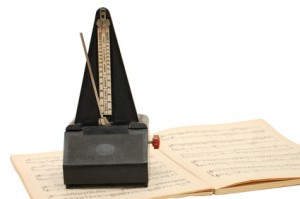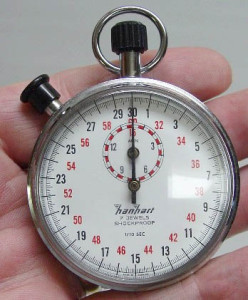 This second post on continuously moving assembly lines will look at the math behind the correlation between the speed of the line (line takt or customer takt), the length of the line, and the amount of work that has to be done on the line. Luckily, the calculations are not very tricky. And, different from a pulsed assembly line, it is perfectly fine to have a continuously moving line that fits not a whole number but a fraction of parts to save space. The tricky part on how to assign the work to the workers will be discussed in the next post of this series.
This second post on continuously moving assembly lines will look at the math behind the correlation between the speed of the line (line takt or customer takt), the length of the line, and the amount of work that has to be done on the line. Luckily, the calculations are not very tricky. And, different from a pulsed assembly line, it is perfectly fine to have a continuously moving line that fits not a whole number but a fraction of parts to save space. The tricky part on how to assign the work to the workers will be discussed in the next post of this series.
Timing a Continuously Moving Assembly Line
 But before I talk about how you can use this unique feature to save space, let’s first talk about the length of the line, its work content, and the customer takt, because these three are the variables that influence each other. The length of the line and the work content determines the line takt (the speed of the line). If this does not meet your expectations (i.e., does not meet the customer takt), then you can either make the line longer or improve and reduce the work content.
But before I talk about how you can use this unique feature to save space, let’s first talk about the length of the line, its work content, and the customer takt, because these three are the variables that influence each other. The length of the line and the work content determines the line takt (the speed of the line). If this does not meet your expectations (i.e., does not meet the customer takt), then you can either make the line longer or improve and reduce the work content.
Parts on Line
 One interim variable needed is also the distance between parts on the continuously moving assembly line, which determines how many parts you can fit on the assembly line. For example, if you have an assembly line that is 25 meters long, and you need half a meter between one part and the next, then you can fit fifty parts on the assembly line. Or, more generally,
One interim variable needed is also the distance between parts on the continuously moving assembly line, which determines how many parts you can fit on the assembly line. For example, if you have an assembly line that is 25 meters long, and you need half a meter between one part and the next, then you can fit fifty parts on the assembly line. Or, more generally,
Possible Line Takt
 From this you can calculate the line takt (average time between parts) based on the work content. One often forgotten small but important detail is that the line takt is the average speed of the line, but the work content is often the ideal speed (i.e., the sum of the cycle times). The sum of your ideal, perfect cycle times would be your work content. However, in any line there will be mishaps, missing materials, breakdowns, absent workers (e.g., bathroom breaks), and more. Hence, if you include all of these losses, you will need more time to do all the work than this ideal work content. (I have a whole blog post on the often confused time and speed measurements in lean manufacturing). Hence, unless your work content is based on average speeds including losses, you must adjust for such losses. This difference is the OEE (Overall Equipment Effectiveness). For example, if your ideal work content without losses is 100 minutes, but you estimate an OEE of 80%, then your real work content including losses is 100 min / 80% = 125 min. Or, more generally:
From this you can calculate the line takt (average time between parts) based on the work content. One often forgotten small but important detail is that the line takt is the average speed of the line, but the work content is often the ideal speed (i.e., the sum of the cycle times). The sum of your ideal, perfect cycle times would be your work content. However, in any line there will be mishaps, missing materials, breakdowns, absent workers (e.g., bathroom breaks), and more. Hence, if you include all of these losses, you will need more time to do all the work than this ideal work content. (I have a whole blog post on the often confused time and speed measurements in lean manufacturing). Hence, unless your work content is based on average speeds including losses, you must adjust for such losses. This difference is the OEE (Overall Equipment Effectiveness). For example, if your ideal work content without losses is 100 minutes, but you estimate an OEE of 80%, then your real work content including losses is 100 min / 80% = 125 min. Or, more generally:
Now we can calculate the possible line takt. If we have a work content including losses of 125 min, and we can fit 50 parts on the line, then we can in average complete one part every 125 min / 50 parts = 2.5 min. Or, more generally:
\[ {Line \; Takt \; (\frac{time}{part})= \frac{Work \; Content \; with \; Losses \; (time)}{Parts \; that \; fit \; on \; line \; (parts) }}\]Matching the Length to the Customer Takt
 If this is not good enough, then we either can fiddle with the length of the line or the work content of the line. For example, if our customer takt is not 2.5 min/part but instead 2 min/part, then we need to match the line takt to the customer takt. One option is of course overtime, but let’s look first at changing the line length. We can change the line length from fitting 50 parts to 125 min / 2 min/part = 62.5 parts. or, more generally,
If this is not good enough, then we either can fiddle with the length of the line or the work content of the line. For example, if our customer takt is not 2.5 min/part but instead 2 min/part, then we need to match the line takt to the customer takt. One option is of course overtime, but let’s look first at changing the line length. We can change the line length from fitting 50 parts to 125 min / 2 min/part = 62.5 parts. or, more generally,
Your gut feeling probably told you to round up the 62.5 parts to 63 parts. And, on a pulsed line you would be totally right. But here is one of the advantages of the continuously moving assembly line: You don’t need to round up to an integer number of stations, but can easily have “half a station” for half a cycle of work, or other any other number that is not a whole integer number. I will talk much more on that in my next post. In any case, if we need 62.5 parts on the line, and each part needs half a meter, then we need a line length of 31.25 meter to make the customer takt if the work content is unchanged.
Matching the Work Content to the Customer Takt
 Another option if you can’t make the customer takt is to change the work content. If your customer takt is 2 min/part and you still can fit only 50 parts on the line, then the allowed work content including losses would be 50 parts ⋅ 2 parts/min or 100 minutes. You would have to improve the work content including losses from 125 min to 100 min by improving standards, providing better tools, or moving work content to subassembly lines. With an OEE of 80% this wold be a reduction of the work content without losses from 125 min ⋅ 80% = 100 min to 100 min ⋅ 80% = 80 min. Or, more generally:
Another option if you can’t make the customer takt is to change the work content. If your customer takt is 2 min/part and you still can fit only 50 parts on the line, then the allowed work content including losses would be 50 parts ⋅ 2 parts/min or 100 minutes. You would have to improve the work content including losses from 125 min to 100 min by improving standards, providing better tools, or moving work content to subassembly lines. With an OEE of 80% this wold be a reduction of the work content without losses from 125 min ⋅ 80% = 100 min to 100 min ⋅ 80% = 80 min. Or, more generally:
from which we can simply calculate the work content without losses as:
\[ {Allowed \; Work \; Content \; without \; Losses \; (time)= \newline = Allowed \; Work \; Content \; with \; Losses \; (time) \times OEE \; (percent)}\]The Speed of the Line
 Finally, the speed of the line is easy to determine. You simply take the work content and divide it by the length of the line. In our example, we had a work content including losses of 100 minutes for an assembly line that was 25 meter long. Hence, the speed of the line has to be set to 25 m /100 min = 0.25 m/min. More generally:
Finally, the speed of the line is easy to determine. You simply take the work content and divide it by the length of the line. In our example, we had a work content including losses of 100 minutes for an assembly line that was 25 meter long. Hence, the speed of the line has to be set to 25 m /100 min = 0.25 m/min. More generally:
This is the underlying math on distributing work on a continuously moving assembly line. The beauty is that you are not limited to a whole integer number of parts on the line, but can easily have space for only a fraction of a part on the line. But please include also some space to put a part on the line and to remove it again from the line. It is also wise to allow some buffers (i.e., space on the line) to handle fluctuations. And finally, even though the time and space on the line is infinitely divisible, your workers are not, and you still require some line balancing. But more on these in my next post. Now, go out, make sure the line takt of your continuously moving assembly line matches the customer takt, and organize your industry!
PS: This series of blog post was inspired by Sobha Modular.

Hi Chris,
Very insightful article about rarely, if not, touched topic.
Here you used Line takt and then matches it with customer takt. What if build takt scenario and use those different takt times it to design the line? It is somehow reverse of your method.
Where can I read more about the topic above? any suggestions are appreciated.
Thanks
Hello Mo, I have a series of 5 posts on continuously moving assembly lines. There you should find more. Other than that I don’t know of any other source on this, this is as far as I know my original research. Cheers!